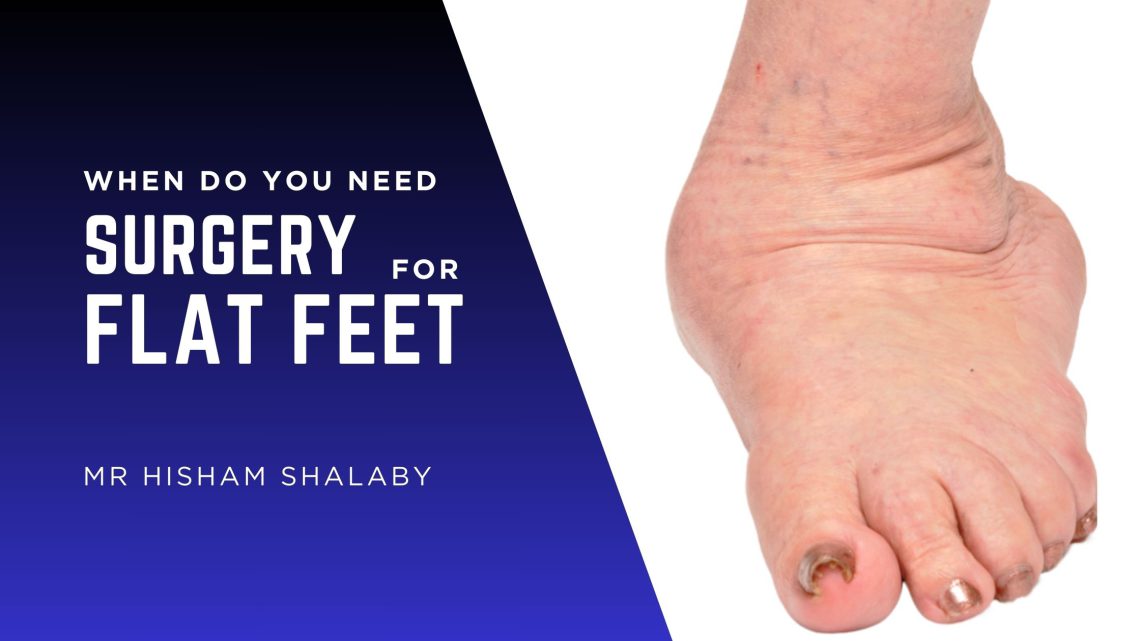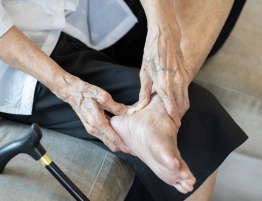
By Mr Hisham Shalaby
Consultant Orthopaedic Foot & Ankle Surgeon
Introduction: Understanding Flat Feet in Adults
Flat feet, or pes planus, refers to a condition where the arches of your feet are flattened, causing the entire sole to touch the ground when standing. While flat feet are common in children, this blog is focused on adultsand the different scenarios where surgery might be necessary. If you want to read about flat feet in kids please refer to my other blog.
The Biomechanics of the Foot and the Role of the Arch
The human foot is a complex structure composed of bones, joints, ligaments, tendons, and muscles, all working together to support the body’s weight and facilitate movement. One of its most vital components is the medial longitudinal arch—a natural curve along the inner side of the foot that plays a critical role in shock absorption and propulsion during walking and running.
A key biomechanical function of the foot is its ability to lock and unlock during the gait cycle:
- Unlocking occurs during the early stance phase (when the heel strikes the ground), allowing the foot to become flexible and adaptable to uneven surfaces.
- As you progress to the push-off phase, the foot locks into a rigid lever arm through the windlass mechanism (tightening of the plantar fascia), making it stable and efficient for propulsion.
In flat feet, this mechanism is compromised. The collapsed arch prevents proper locking, leaving the foot floppy and flexible throughout the gait cycle. Without the rigid lever arm, the foot struggles to generate sufficient push-off force, requiring more muscular effort and energy during walking. Over time, this inefficiency can lead to fatigue, discomfort, and pain not only in the feet but also in the knees, hips, and lower back, as the body compensates for the lack of proper foot mechanics.
This is why, even in the absence of pain, correcting abnormal foot biomechanics through supportive devices (like orthotics) or, in severe cases, surgery, can be crucial for maintaining overall mobility and reducing strain on the musculoskeletal system.
In most cases, flat feet do not require surgery, and many adults live without symptoms. However, there are times when flat feet can cause pain, dysfunction, or progressive deformity, leading to the need for more advanced treatments, including surgery.
Let’s break down the different causes, symptoms, and treatment options, so you know when to consider seeing a specialist.
Types of Flat Feet in Adults
- Flexible Flatfoot in Young Adults
- This is usually a continuation of flat feet from childhood. The arch appears when the foot is off the ground (non-weight bearing), but flattens when standing.
- Symptoms: Many remain asymptomatic, but some may experience aching in the feet, legs, or lower back after prolonged activity.
- Management: Conservative treatments like arch supports, footwear changes, and physiotherapywork well.
- When is surgery needed?
When non-operative treatments fail for symptomatic flexible flatfoot in young adults, reconstructive procedures aim to restore the medial arch and correct alignment. Evidence supports calcaneal osteotomies (realigning the heel bone) combined with soft tissue procedures like gastrocnemius recession (if calf tightness exists) and posterior tibial tendon augmentation or transfer. Studies such as Wacker et al. (2017) have shown that these procedures improve functional outcomes and foot alignment with high patient satisfaction. (Wacker, J., et al., Foot & Ankle International, 2017)
- Rigid Flatfoot in Young Adults (e.g., Tarsal Coalition)
- Tarsal coalition is when two or more bones in the foot are abnormally connected, restricting motion and causing rigid flatfoot.
- Symptoms: Pain, stiffness, and difficulty walking on uneven surfaces. This usually presents in teenagers or young adults.
- Management: Initial treatment includes activity modification, orthotics, and immobilization.
- When is surgery needed?
Surgical options for symptomatic tarsal coalition include resection of the coalition (removal of the abnormal connection) to restore motion. This approach is effective in younger patients without significant arthritic changes. When arthritis is present, subtalar or triple arthrodesis (fusion of joints) is recommended. Research by Wild et al. (2014) confirms that coalition resection with interposition (fat graft) yields favorable outcomes in terms of pain relief and restored function in non-arthritic cases. (Wild, J. R. A., et al., Journal of Pediatric Orthopaedics, 2014)
- Flatfoot in Middle-Aged and Older Adults (Posterior Tibial Tendon Dysfunction – PTTD)
- The posterior tibial tendon supports the arch. Over time, wear and tear can lead to Posterior Tibial Tendon Dysfunction (PTTD), a leading cause of adult-acquired flatfoot.
- Typically affects people in their 40s, 50s, or older.
- Symptoms: Progressive flattening of the foot, pain along the inside of the ankle or arch, swelling, and difficulty standing on tiptoes.
- Stages of PTTD:
- Stage I-II: Tendon inflammation and some arch collapse (flexible deformity).
- Stage III-IV: Severe collapse and arthritis (rigid deformity).
- Management: Early stages respond to orthotics, bracing, and physiotherapy. Advanced stages may require surgery.
- When is surgery needed?
For advanced PTTD (Stage II and beyond), flexible deformities are treated with tendon transfers (e.g., flexor digitorum longus transfer), calcaneal osteotomies, and medial column procedures. In rigid deformities with joint degeneration (Stage III-IV), triple arthrodesis (fusion of the subtalar, talonavicular, and calcaneocuboid joints) or double arthrodesis is indicated. Studies such as Myerson et al. (2011) provide strong evidence that these staged reconstructions improve alignment and pain relief in PTTD. (Myerson, M. S., et al., Foot and Ankle Clinics, 2011)
- Other Causes of Flatfoot in Adults
a) Charcot Arthropathy (common in diabetics):
- A condition where nerve damage (neuropathy) leads to joint collapse and deformity.
- Symptoms: Swelling, redness, warmth, and progressive deformity without much pain.
- Management: Urgent immobilization in the acute phase.
- When is surgery needed?
Surgical intervention is typically reserved for severe deformity or instability that risks ulceration or amputation. Realignment arthrodesis (fusion) with robust internal or external fixation is the standard, supported by Eichenholtz stage-based protocols. Recent studies, like those by Pinzur (2019), show that stable fusion constructs reduce ulceration risk and improve limb salvage rates. (Pinzur, M. S., Foot & Ankle International, 2019).
b) Post-Traumatic Flatfoot:
- Follows fractures, ligament injuries, or dislocations that disrupt the foot’s structure.
- When is surgery needed?
If the injury leads to chronic instability, arthritis, or deformity that affects function or causes pain. Depending on the extent of joint involvement and instability, surgical options include osteotomies for realignment or joint fusions
c) Degenerative Flatfoot:
- Develops from arthritis affecting joints of the midfoot or hindfoot.
- Symptoms: Pain, stiffness, progressive flattening.
- When is surgery needed?
For flatfoot deformities due to midfoot or hindfoot arthritis, joint fusion procedures are the gold standard. Isolated midfoot fusions or triple arthrodesis are used depending on the extent of arthritis. Thomas et al. (2009) report that these surgical approaches significantly reduce pain and improve function, particularly when conservative management has failed. (Thomas, J. L., et al., Journal of Foot and Ankle Surgery, 2009)
When to See a Specialist
You should consult a foot and ankle orthopaedic surgeon if:
- You experience persistent pain or swelling in the foot or ankle.
- Your foot shape is changing over time.
- You have difficulty walking, standing, or balancing.
- Conservative treatments fail to improve your symptoms.
Conclusion: Surgery is Rare, but Sometimes Necessary
For most adults with flat feet, non-surgical treatments work well. However, persistent pain, progressive deformity, or functional limitations may warrant surgical evaluation. Early diagnosis and intervention can prevent worsening of the condition and help maintain mobility and quality of life.
If you’re unsure about your symptoms or treatment options, it’s best to seek advice from a qualified orthopaedic foot and ankle specialist.
References:
- Bluman, E. M., Title, C. I., & Myerson, M. S. (2007). Posterior tibial tendon rupture: A refined classification system. Foot & Ankle Clinics, 12(2), 233-249. DOI: 10.1016/j.fcl.2007.03.001
- Haddad, S. L., et al. (2011). Adult-Acquired Flatfoot Deformity. Journal of the American Academy of Orthopaedic Surgeons, 19(6), 314-322. DOI: 10.5435/00124635-201106000-00003
- Kiter, E., et al. (2007). Flexible flatfoot and related factors in primary school children: a report of a screening study. Rheumatology International, 27(11), 1057-1061. DOI: 10.1007/s00296-007-0378-0
- Myerson, M. S., & Corrigan, J. (2010). Treatment of adult acquired flatfoot deformity with a staged approach. Foot and Ankle Clinics, 15(2), 341-359. DOI: 10.1016/j.fcl.2010.01.005
- Malicky, D. M., et al. (2002). Tarsal coalition: A retrospective review of 42 cases. Foot & Ankle International, 23(6), 503-507. DOI: 10.1177/107110070202300604
- Chantelau, E., & Grützner, G. (2003). Is the Eichenholtz classification still valid for the diabetic Charcot foot? Swiss Medical Weekly, 133(35-36), 461-466. DOI: 2003/35/smw-10264
- Thomas, J. L., et al. (2009). The diagnosis and treatment of adult flatfoot. Journal of Foot and Ankle Surgery, 48(1), 1-19. DOI: 10.1053/j.jfas.2008.11.005
- Easley, M. E., & Trnka, H. J. (2007). Current concepts review: Adult acquired flatfoot deformity. Foot & Ankle International, 28(4), 392-408. DOI: 10.3113/FAI.2007.0392





